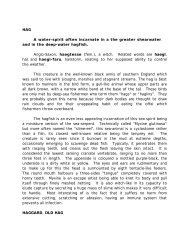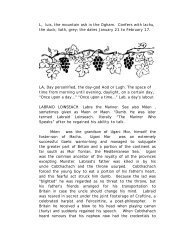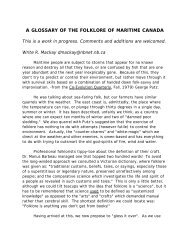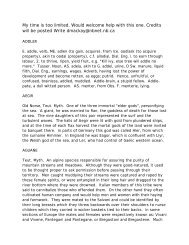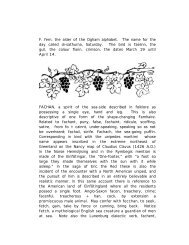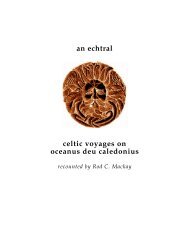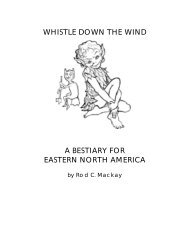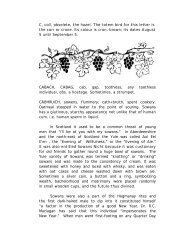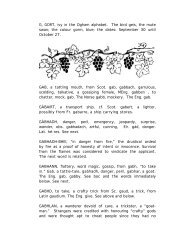R, ruis, the dwarf elder in Ogham. The rochat, or ... - Rodney Mackay
R, ruis, the dwarf elder in Ogham. The rochat, or ... - Rodney Mackay
R, ruis, the dwarf elder in Ogham. The rochat, or ... - Rodney Mackay
Create successful ePaper yourself
Turn your PDF publications into a flip-book with our unique Google optimized e-Paper software.
digg<strong>in</strong>g up <strong>the</strong> latter. Ràth <strong>or</strong>ig<strong>in</strong>ally referred to <strong>the</strong><br />
enclos<strong>in</strong>g ear<strong>the</strong>n bank and lios to <strong>the</strong> open space between<br />
this and <strong>the</strong> dwell<strong>in</strong>g places with<strong>in</strong>, but <strong>the</strong> w<strong>or</strong>d ràth is<br />
now used to identify f<strong>or</strong>tifications which are round, <strong>in</strong><br />
sh<strong>or</strong>t, ear<strong>the</strong>n-r<strong>in</strong>g f<strong>or</strong>ts. It is generally held that <strong>the</strong>se<br />
embankments had no military significance although <strong>the</strong>y<br />
may have saved cattle from <strong>the</strong> wolves. It is possible, of<br />
course, that wooden palisades might once have been erected<br />
upon <strong>the</strong> "rath."<br />
<strong>The</strong> r<strong>in</strong>g-f<strong>or</strong>ts vary greatly <strong>in</strong> size, and <strong>the</strong>ir rema<strong>in</strong>s<br />
range from 50 feet <strong>in</strong> diameter to about 400 feet. Examples<br />
of large, multi-circled raths are uncommon but <strong>the</strong>y do<br />
exist and be<strong>in</strong>g sited on high land are referred to as hillf<strong>or</strong>ts.<br />
Exam<strong>in</strong>ation of artifacts associated with <strong>the</strong>se r<strong>in</strong>ged<br />
structures shows that some are pre-Celtic dat<strong>in</strong>g back to<br />
<strong>the</strong> Bronze Age. Some of <strong>the</strong> stone circles, f<strong>or</strong>merly<br />
regarded as ritual sites, have recently shown evidence of<br />
past habitation, and it is now known that <strong>the</strong> uprights were<br />
placed as a framew<strong>or</strong>k f<strong>or</strong> build<strong>in</strong>g banks of rubble, sod and<br />
earth. In some cases wooden posts had <strong>the</strong> function of<br />
<strong>the</strong>se upright stones and <strong>in</strong> <strong>the</strong>se cases all that rema<strong>in</strong>s is<br />
circular plug-holes to <strong>in</strong>dicate this style of construction. It<br />
is assumed some of r<strong>in</strong>g-f<strong>or</strong>ts were defensive <strong>in</strong> <strong>in</strong>tent, but<br />
many have “one slight bank and a shallow fosse,” whose<br />
security must have been <strong>the</strong>ological ra<strong>the</strong>r than military <strong>in</strong><br />
<strong>in</strong>tent.<br />
See follow<strong>in</strong>g.<br />
RÀTH. Circle, <strong>the</strong> mar<strong>in</strong>er dismembered by <strong>the</strong> mer-people<br />
after a female of <strong>the</strong>ir k<strong>in</strong>d lulled him to sleep with her<br />
song; a not uncommon fate f<strong>or</strong> <strong>in</strong>terlopers on <strong>the</strong> great<br />
western ocean.<br />
RÀTHCROGAN, RATHCHROGAN. One of <strong>the</strong> largest raths of<br />
ancient times was that held by Queen Mebd and her cons<strong>or</strong>t<br />
Ailill, which was called Rath Cruachan <strong>or</strong> Rathcrogan. Its<br />
outer circle encompassed numerous o<strong>the</strong>r f<strong>or</strong>tresses, and<br />
<strong>the</strong> place was still used <strong>in</strong> 645 A.D., when <strong>the</strong> Connaught



